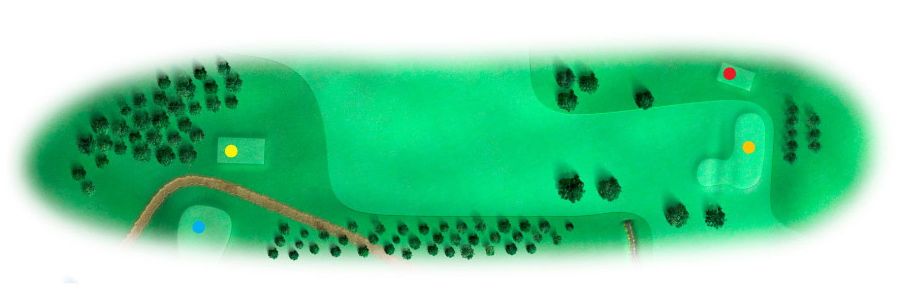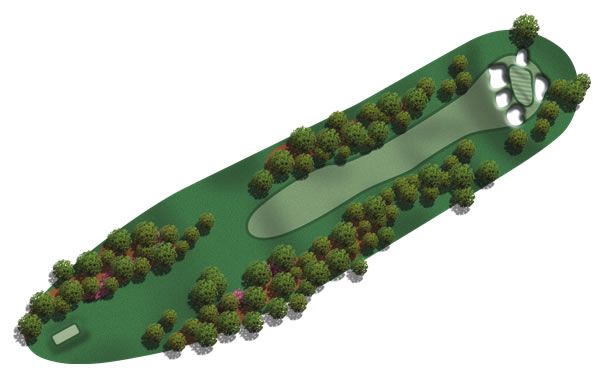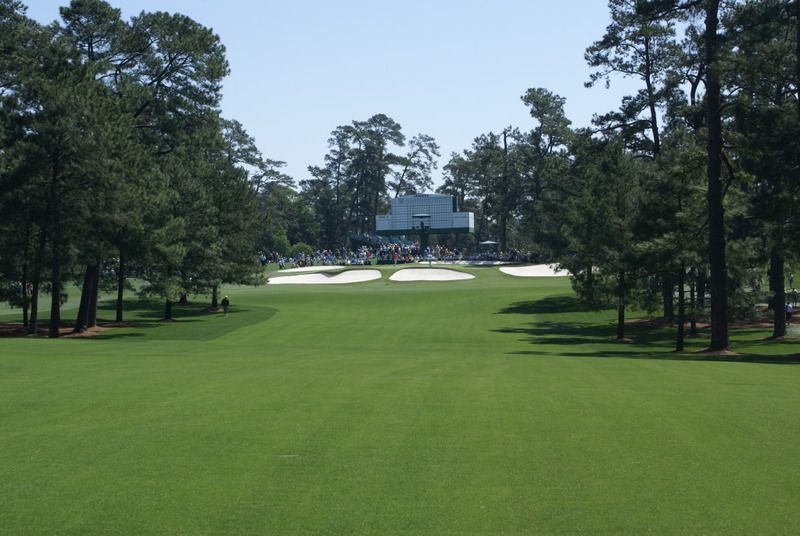As Colin pointed out, time is running short before the first high-powered European luxury courtesy car ventures up Magnolia Lane. In some ways, the 80 degree weather in Chicago makes it feel like I missed the tournament altogether. Its a rare year when I see spring blooms in person before I see them while Jim Nantz's is calling me a "friend." But since we are still a week or so away, we'll move on to the Seventh.
Before we do, quick thanks to Colin for the article, John K. for the photos and Chris B. for the side-by-side historical overheads. And if anyone wants to chime in to let me know what a Pampas is I'd appreciate it.
7th Hole - Pampas - Par 4


1934 - 340 yards - Intended as a version of the 18th at St. Andrew's, this hole disappointed Bobby Jones. "By championship standards, [it] played to short," he wrote. "The contouring of the green did not correspond with our original objective...too severe, or if you choose, too tricky." Byron Nelson reached the green from the tee when he won in 1937.
1939 - 370 yards - At the behest of Roberts, Maxwell reshaped portions of the green in 1937, but concluded no one could truly improve it. At the suggestion of Horton Smith, a new green was built in 1938 beyond the old one, atop a hill. Paid for by a club member, it was build with a tractor borrowed from the county. Maxwell, on direction to make the new green similar to the par-4 8th at Pine Valley, fronted the green with three bunkers.
1956 - 365 yards - As if the smallest green (3,600 sf) sitting half-blind 15 feet above the fairway wasn't testing enough, George Cobb added two bunkers behind the green before the 1955 Masters. Pines trees were also planted along the fairway. The next summer, the hillside behind the green was cleared to create a gallery mound.
2002 - 410 yards - In 1966, the bunkers had to be deepened to prevent players from putting out of them. In 1994, the green was enlarged on the left for new hole locations. A new back tee added 50 yards in 2002. Fazio explained this change by saying "long hitters were driving it past the trees and onto the upslope, leaving them a 50-yard approach they could hit with no spin and stick close to the hole."
2011 - 450 yards - In 2005, the back-right corner of the green was softened for new hole locations. Additional pines were planted on both sides of the fairway effectively tightening the playing corridor. The tee was moved back an additional 40 yards into what originally had been the maintenance yard. The new tee required a walk back from the 6th green of 80 yards.
As always, Dan's write-up gets to the heart of the matter:
"Few holes at Augusta National have been altered to the extent that the par-4 seventh has; indeed, aside from remaining in its original playing corridor, it is today an entirely different hole from that which Jones and MacKenzie created in 1933. Their original was a bunkerless drive-and-pitch modeled after the 18th at St. Andrews, running straight away and culminating in a shallow, three-tiered green with a prominent front-right finger, and a Valley of Sin-like depression guarding the front-left. Deemed too easy early in life, it was soon replaced by a “Postage Stamp” concept reportedly suggested by Horton Smith; that is, the small, somewhat elevated, and closely guarded putting surface which Perry Maxwell constructed on a rise behind the original green site in 1938. This comparably shallow target was initially fronted by the same three bunkers that remain before it today, with the back two bunkers only being added much later, in 1951.
By the new millennium, however, the club deemed that version too easy as well, leading Tom Fazio to extend the hole to 445 yards and narrow its fairway with the addition of both trees and rough. The result, while undeniably challenging, now bears zero resemblance to the Jones and MacKenzie original. It is, however, at least partially defendable if one accepts the notion that Jones’s word represents the Augusta gospel, for he clearly endorsed the narrowing concept (at least if accomplished via flora) back in 1959, when he wrote: “The tee shot on this hole becomes tighter year by year as the pine trees on either side of the fairway continue to spread. Length is not a premium here, but the narrow fairway seems to have an added impact because it suddenly confronts the player when he has become accustomed to the broad expanses of the preceding holes.”
But that said, the present version easily draws more (and louder) negative Masters comments than any hole at Augusta.
Better Then or Now?
For whom? While members might well enjoy the subtle challenges of the seventh hole circa 1933, with modern technology it would scarcely even be considered a par 4 for Masters competitors, who would drive indiscriminately towards the green and, at worst, hope for two-putt birdies from the Valley of Sin. The pre-Fazio postage stamp version, on the other hand, was still manageable for the members and quirky/fun for the pros. The present version is simply brutal unless one favors the sort of stilted, hit-it-here-or-else style of play incumbent to a modern U.S. Open, in which case we have a winner."
The write-up noted above by Zach Johnson's caddy indicates that they thought this hole to be the toughest on the course. The size of the green certainly presents a tough target on a hole of its current length.
The original "Valley of Sin" design raises the question of whether or not MacKenzie thought of this hole as driveable. Even if he did, its apparent that Jones and others preferred a hole with a bit more challenge. One has to wonder if the final result meets or pushes past their vision. It would not be surprising if the 7th green was altered further to make it more receptive to longer approaches.
